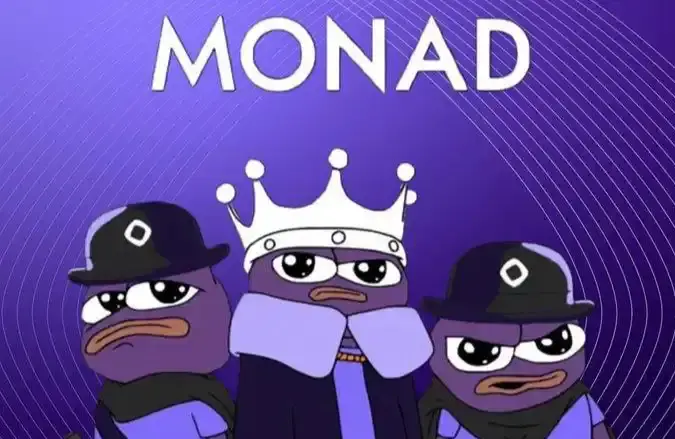The ecological project has attracted over ten million dollars. What early opportunities for profit does Monad still have?
Author: Xiyou, ChainCatcher
Editor: Marco, ChainCatcher
On July 25, the Monad ecosystem project announced three consecutive financings of over one million dollars.
Among them, the MEV infrastructure and liquid staking platform aPriori secured $8 million in seed funding led by Pantera Capital, reportedly valuing aPriori tokens at at least $100 million; the liquid staking protocol Kintsu completed $4 million in financing; and the on-chain order platform Kuru received $2 million in funding led by Electric Capital.
The investment lineup for this Monad ecosystem project is quite impressive, featuring not only star investment institutions like Pantera and Electric but also many well-known industry figures such as Marin Tvrdic from Lido and the founders of Wormhole.
Since Monad announced a $225 million financing at a $3 billion valuation in April, the recent announcements of top capital support for ecosystem projects have further increased its network popularity.
Crypto KOL AB Kuai.Dong stated on social media that one distinguishing feature of Monad is that while many public chains have strong backing from their own investors, the applications built on them often do not make much of an impact. In contrast, Monad has applications under construction that have also received investment from well-known institutions, such as Kintsu, Kuru, Monad Pad, and aPriori.
As the launch of the testnet approaches, the Monad ecosystem is becoming a new gold rush opportunity for the crypto community.
Why Does Capital Favor the Monad Ecosystem?
Monad is a high-performance Layer 1 network dedicated to solving traditional EVM scalability issues, focusing on the concept of "Parallel EVM," aiming to improve and enhance the execution efficiency of EVM in Layer 1 networks by introducing "parallel processing" and pipelining architecture at the execution layer.
The founding team largely comes from the market-making giant Jump Trading, with founder Keone Hon having served as the head of research at Jump Trading for eight years, and co-founder James Hunsaker being a senior software engineer at Jump Trading and a core maintainer of Pyth Network. James Hunsaker was also the whistleblower in last year's Jump Trading manipulation case involving Terra (UST).
Since April, when Monad announced a $225 million financing at a $3 billion valuation led by Paradigm, with participation from many well-known institutions including Electric Capital, Amber Group, Animoca Ventures, Bankless Ventures, Coinbase Ventures, and Wintermute Ventures, every move from the official team has attracted significant attention from the crypto community.
Currently, the Monad testnet is still in the internal testing phase and has not been fully opened to the public. According to recent statements from Monad officials on the X platform, the testnet is set to launch soon, reportedly in Q3.
According to founder Keone's public interview, the mainnet is expected to be launched in mid-2024.
Regarding the development of the Monad ecosystem, CMS Holdings partner Matuszewski stated in a recent public interview that in the past few months, more and more Monad projects have raised funds, and from now until autumn, these projects will gradually go public, with another wave of Monad-based projects expected to emerge before the mainnet launch.
Why do venture capital firms favor Monad and its ecosystem projects? Several participating investors expressed strong optimism about Monad's prospects, particularly its high transaction volume per second and Ethereum Virtual Machine (EVM) compatibility, which allows the Monad network to handle multiple transactions simultaneously, improving throughput compared to traditional sequential methods.
Among them, Monad's parallel execution and potential throughput of up to 10,000 transactions per second can unlock many previously impossible on-chain activities, building applications based on the Solana ecosystem such as social, gaming, DeFi, payments, and DePIN; on the other hand, EVM compatibility allows developers to use their familiar Solidity to develop projects on Monad without any changes.
Some believe that the launch of Monad will create competition with Solana.
AB Kuai.Dong previously stated on social media that Monad is like Ethereum's direct competitor to Solana, as seen from the node configuration requirements in the white paper and the narrative of high performance, comparing it with Solana, which is also a Layer 1. Additionally, investors who had previously not invested in Solana have collectively appeared on the investor list for Monad and its ecosystem projects.
Aric Chang, partner at Manifold Ventures and investor in aPriori, stated that Monad's growth trajectory could potentially surpass Solana, attracting a diverse ecosystem of DeFi and consumer-facing applications.
Regarding the relationship between Monad, Ethereum, and Solana, founder Keone has stated in public interviews that Monad is more like a child born from the combination of Ethereum and Solana.
Monad emphasizes complete compatibility with Ethereum, ensuring bytecode EVM compatibility and Ethereum RPC compatibility, reducing the difficulty for developers to migrate; in terms of high performance and optimization, it is similar to Solana, although there are differences in execution parallelization and transaction formats.
Monad combines the compatibility of Ethereum with the high performance of Solana, forming its unique advantages.
What Are the Opportunities and Participation Methods in the Monad Ecosystem?
According to the crypto data platform RootData, there are 22 recorded Monad ecosystem projects covering DeFi, NFTs, oracles, and more.

1. IDO Platform Monad Pad
Monad Pad is a token and NFT launch platform built on Monad, supporting project parties or developers to initiate early fundraising for tokens or NFTs through pre-sales or public sales. The project announced on July 5 that it completed $945,000 in seed funding, with participating institutions including CMS, Sneaky Ventures, and others.
Currently, Monad Pad has issued its original NFT series Purple Frens, which features purple frogs as its PFP NFT series, with a total issuance of 3,333, and an initial price of $500 for each NFT. Additionally, 20% of the revenue from the Monad Pad platform will be distributed to holders of this NFT series.
MPAD is the native token of the Monad Pad platform, with a total issuance of 100 million tokens, of which 10% (10 million tokens) will be allocated to Purple Frens NFT holders through staking.
As of August 12, the NFT series Purple Frens issued by Monad Pad has not yet been publicly sold, and the token MPAD has not been listed. Users wishing to participate in the public sale need to have a whitelist. There are two ways to participate: first, users can join the lottery activities announced on the official Twitter of Monad Pad and Purple Frens to participate in the NFT minting whitelist; second, users can engage in the Discord community, be active, and obtain roles to gain the whitelist.
2. MEV Infrastructure and Liquid Staking Platform aPriori
aPriori is the MEV infrastructure and liquid staking platform within the Monad ecosystem. Its founder Ray previously worked at Jump Crypto and Flow Traders, and is a core contributor to Pyth Network, while CTO Olivia comes from Coinbase.
On July 25, aPriori announced it completed $8 million in seed funding led by Pantera Capital, adding to the $2.7 million Pre-seed funding announced in January, bringing the total disclosed funding amount to $10.7 million. Additionally, on July 30, Binance Labs also announced its investment in the aPriori project.
Currently, aPriori's products are not publicly available; the official website only supports links to Twitter, Discord, and the official blog. Users can participate in its Discord community activities to obtain special roles, etc.
3. Liquid Staking Protocol Kintsu
Kintsu is a liquid staking protocol built on the ZK privacy public chain Aleph Zero and Monad, aiming to create an innovative LST product to become a foundational component of DeFi on Monad. The project was created by Stephen Novenstern, who was the strategic director of the well-known DEX platform Pangolin in the Avalanche ecosystem.
On the same day that aPriori announced its financing, Kintsu also publicly stated that it secured $4 million in funding led by Castle Island Ventures, with participating institutions including CMT Digital, Spartan Group, Breed VC, CMS Holdings, Animoca Ventures, as well as Marin Tvrdic from Lido and Robinson Burkey, co-founder of Wormhole. Its sMONAD liquid staking token based on Monad will be launched in the first week after the Monad mainnet release.
Currently, Kintsu has launched the liquid staking product sTZERO on the Aleph Zero testnet, allowing users to stake Aleph Zero network tokens TZERO to receive the liquid staking certificate sTZERO.
Additionally, users can also obtain OG roles by participating in Kintsu's ambassador program or reaching level 35 in Discord.
4. Decentralized Order Book Trading Kuru
Kuru is a decentralized order book (CLOB) exchange on the Monad ecosystem, which announced on July 25 that it secured $2 million in seed funding led by Electric Capital, with participation from CMS Holdings, Breed VC, and Monad CEO Keone Hon.
The day of the public financing was also the first time Kuru officially spoke out. Currently, Kuru is in a very early stage, and its product has not yet been publicly released. The official website only has links to Discord and Twitter, and the blog content has only published one financing announcement.
The Discord community has closed new user entry, and according to official information, it will reopen to users this week.
5. NFT Trading Platform Poply
Poply is an NFT trading market based on Monad, supporting creators to issue or trade NFT works. The product is still in the early development stage, and users wishing to experience the Poply platform can apply for a waitlist.
On August 6, Poply launched a bounty activity on the task platform Galex before the testnet launch to reward early supporters. Users can earn points or NFT rewards by completing retweets, liking tweets, and joining the Discord community.
6. Decentralized Prediction Market Castora
Castora is a decentralized P2P prediction market built on Monad, similar to the recently popular Polymarket. Currently, the Castora platform has opened an Ethereum price prediction pool, with a betting fee of 10 USDC. If the price reaches the predicted value within the specified time, the bettor will receive all the funds in the betting pool.
7. Liquid Staking Protocol Magma
Magma is a liquid staking protocol developed by Hydrogen Labs based on Monad.
Hydrogen Labs is a Web3 infrastructure incubation platform that has developed stablecoin protocols like Fluid Protocol based on the modular public chain Fuel, the EigenLayer AVS optimization server Anzen, and the Bitcoin liquid staking protocol Rover.
Currently, users wishing to learn about Magma can join the Discord community to become early participants.


















